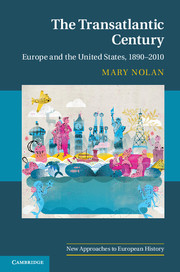Book contents
- Frontmatter
- Contents
- Illustrations
- Maps
- Tables
- Acknowledgments
- Introduction
- 1 An uncertain balance, 1890–1914
- 2 World War I: European crisis and American opportunity
- 3 Ambivalent engagement
- 4 The depression and transatlantic new deals
- 5 Strange affinities, new enemies
- 6 From world war to Cold War
- 7 Cooperation, competition, containment
- 8 Culture wars
- 9 The American Century erodes, 1968–1979
- 10 Renewed conflict and surprising collapse
- 11 A widening Atlantic
- 12 Imperial America, estranged Europe
- Suggested readings
- Index
- References
8 - Culture wars
Published online by Cambridge University Press: 05 November 2012
- Frontmatter
- Contents
- Illustrations
- Maps
- Tables
- Acknowledgments
- Introduction
- 1 An uncertain balance, 1890–1914
- 2 World War I: European crisis and American opportunity
- 3 Ambivalent engagement
- 4 The depression and transatlantic new deals
- 5 Strange affinities, new enemies
- 6 From world war to Cold War
- 7 Cooperation, competition, containment
- 8 Culture wars
- 9 The American Century erodes, 1968–1979
- 10 Renewed conflict and surprising collapse
- 11 A widening Atlantic
- 12 Imperial America, estranged Europe
- Suggested readings
- Index
- References
Summary
Cultural conflicts abounded in the postwar transatlantic world. Many involved the Americanization – actual or imagined – of Western European high culture, popular entertainment, and everyday life. Americanization was hardly new but was greatly intensified by United States postwar prosperity, business and government determination to export cultural products and the American way of life, and the pervasive crisis on the other side of the Atlantic. While some Western Europeans welcomed Americanization, many others, east and west, viewed culture as a terrain on which to fight to preserve their national patrimony and identities. And Eastern European communists felt almost as threatened by the soft power of American movies and music as by American troops and nukes.
Other cultural conflicts were an integral part of the Cold War, for the superpowers and their allies and satellites took culture seriously and viewed it as political. Soviets and Americans saw culture as a vehicle to assert the superiority of their own system, arouse envy and discontent in the enemy camp, and win adherents for communism or capitalist democracy. At home it was a means to manufacture consent and create new men and women. Culture was defined capaciously and fought over in multiple arenas ranging from elite art exhibits and operas through urban design and academic exchanges to movies and sports. It included consumer culture and domesticity as well. Cultural competition spanned the public and private, involved business and states, and targeted everyone from intellectuals and artists to youth and housewives.
- Type
- Chapter
- Information
- The Transatlantic CenturyEurope and America, 1890–2010, pp. 230 - 266Publisher: Cambridge University PressPrint publication year: 2012

